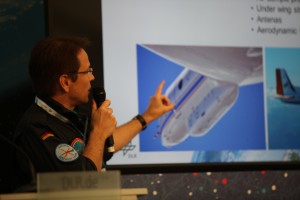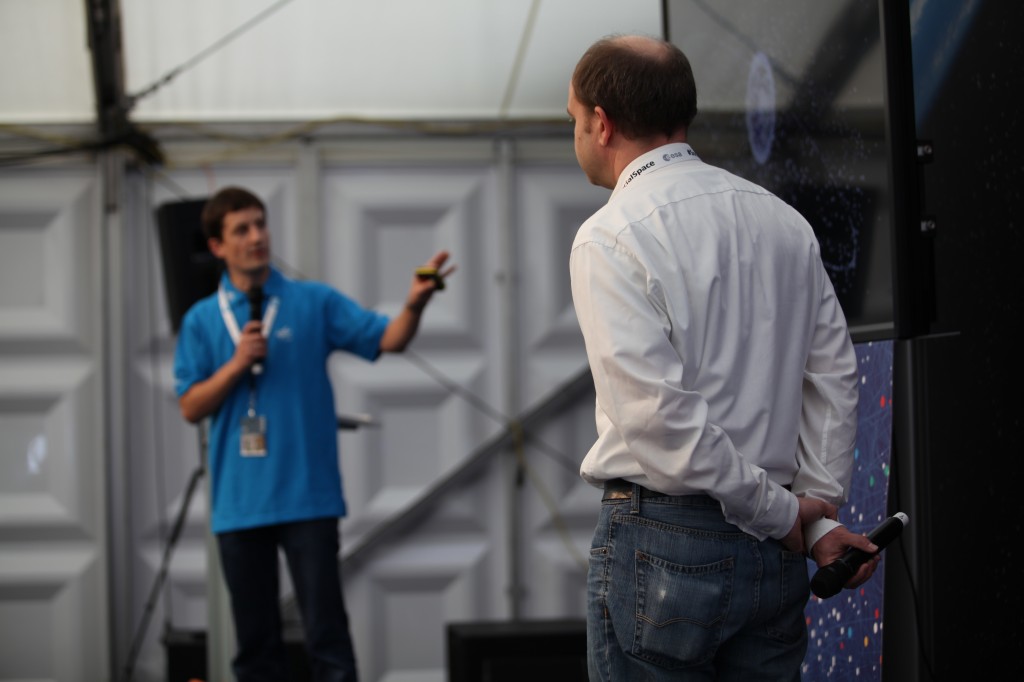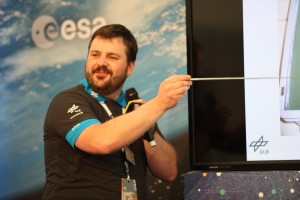Spacetweeps got a chance to see what kind of research goes on at DLR and ESA when Jens Hauslage, Stefan Gemsa, Manuel Metz and Holger Krag presented some of their activities.
Jens Hauslage of DLR was first on stage, explaining how soil can be fertilized in a closed system like a space station, although he says Earth is the nicest spacecraft.
He presented CROP, Combined Regenerative Organic Food Production, explaining that composting is not an option on a space station and showed instead a filtration system based on lava rocks for transforming urea into nitrates for fertilizer.
This can save on using inorganic and expensive fertilizers. You can see some of the results of his team’s work here.
DLR test pilot Stefan Gemsa explained what kind of special attributes a pilot needs to have to do his job.

Test pilot Stefan Gemsa talks about what it takes to do his job – and what he does Credit: DLR/ESA/A. Morellon (CC-BY 3.0)
To be a test pilot you need a natural sciences or engineering background and have ratings in aerobatic flight. Then further training can be taken at one of five schools for test pilots around the world. Training can include flying dozens of different aircraft and long periods away from home.
During a test flight, a test plan must be followed, and the pilot should be highly qualified and experienced.
DLR operates a wide range of fixed wing aircraft, as well as helicopters. Test pilots check how different equipment can affect aircraft as well as conducting stall tests, and assessing performance of an aeroplane flying on one engine, should it lose power to the other engine in flight.
Stefan Gemsa flew special missions during the Eyjafjallajokull volanic eruption, which halted European air traffic in April 2010. He helped to assess the amount of ash in the atmosphere and its possible impact on civilian aeroplanes.

Manuel Metz (left) shows an animation of space debris on stage with Holger Krag (right) Credit: DLR/ESA/A. Morellon (CC-BY 3.0)
ESA’s Holger Krag and DLR’s Manuel Metz gave their presentations about space debris and what space agencies can do about it.
Space debris showed two sharp jumps since the turn of the century: the destruction of a satellite in 2007 and a collision between two satellites in 2009 created lots of new small objects in Earth’s orbit.
Manuel Metz of DLR explained that space debris objects can be measured and tracked using radar and radio telescopes. Tests are also continuing into how to shield objects better in case of space debris impact.
ESA’s Holger Krag explained that models can be used to predict the risk of collisions in different Earth orbits – whether at 400km where the International Space Station is usually in orbit, or at 36,000 km where geostationary satellites used for communications and weather are concentrated.
The need to reduce space debris is being addressed. There have been changes in policy to make satellite owners de-orbit satellites once their missions are complete. A bigger challenge is actively to de-orbit other older objects that are still in orbit – proposed methods include capturing objects in a form of net. You can find out more here.


Discussion: no comments